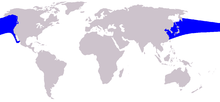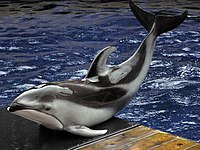Pacific white-sided dolphin
| Pacific white-sided dolphin[1] | |
|---|---|

| |

| |
| Size compared to an average human | |
| Scientific classification | |
| Domain: | Eukaryota |
| Kingdom: | Animalia |
| Phylum: | Chordata |
| Class: | Mammalia |
| Order: | Artiodactyla |
| Infraorder: | Cetacea |
| Family: | Delphinidae |
| Genus: | Lagenorhynchus |
| Species: | L. obliquidens
|
| Binomial name | |
| Lagenorhynchus obliquidens (Gill, 1865)
| |

| |
| Pacific white-sided dolphin range | |
The Pacific white-sided dolphin (Lagenorhynchus obliquidens), also known as the hookfin porpoise, is an active dolphin found in the cool or temperate waters of the North Pacific Ocean.[4][5]
Taxonomy
The Pacific white-sided dolphin was named by Smithsonian mammalogist Theodore Nicholas Gill in 1865. It is morphologically similar to the dusky dolphin, which is found in the South Pacific.[6] Genetic analysis by Frank Cipriano suggests the two species diverged around two million years ago.
Though traditionally placed in the genus
Description

The Pacific white-sided dolphin has three colors. The chin, throat and belly are creamy white. The beak, flippers, back, and dorsal fin are a dark gray. Light gray patches are seen on the sides and a further light gray stripe runs from above the eye to below the dorsal fin, where it thickens along the tail stock. A dark gray ring surrounds the eyes.
The species is an average-sized oceanic dolphin. Females weigh up to 150 kg (330 lb) and males 200 kg (440 lb) with males reaching 2.5 m (8.2 ft) and females 2.3 m (7.5 ft) in length. Pacific white-sided dolphins usually tend to be larger than dusky dolphins. Females reach maturity at seven years. From 1990 to 1991, a study conducted by Richard C. Ferrero and William A. Walker revealed the vast majority of Pacific white-sided dolphins that fell victim to the drift nets were between the ages of 8.3 to 11 when they sexually matured.[8] The gestation period usually last for one year. Individuals are believed to live up 40 years or more.[6]
The Pacific white-sided dolphin is extremely active and mixes with many of the other North Pacific cetacean species. It readily approaches boats and bow-rides. Large groups are common, averaging 90 individuals, with supergroups of more than 300. Prey includes mainly hake, anchovies, squid, herring, salmon, and cod.[9]
They have an average of 60 teeth.[10]
Range and habitat
The range of the Pacific white-sided dolphin arcs across the cool to temperate waters of the North Pacific.
The total population may be as many as 1 million.[6] However, the tendency of Pacific white-sided dolphins to approach boats complicates precise estimates via sampling.
Behavior
These dolphins keep close company.[17] White-sided dolphins swim in groups of 10 to 100, and can often be seen bow-riding and doing somersaults.[6][18] Members form a close-knit group and will often care for a sick or injured dolphin. Animals that live in such large social groups develop ways to keep in touch, with each dolphin identifying itself by a unique name-whistle. Young dolphins communicate with a touch of a flipper as they swim beside adults.
Studies conducted on Pacific white-sided dolphins, as well as
The first sighting of the species on Commander Islands involved a single dolphin to travel along with a pod of killer whales in 2013.[23]
Pacific white-sided dolphins are known to sleep on average seven hours a night.[24]
Relation to humans
Right: Pacific white-sided dolphin named Spinnaker at Vancouver Aquarium
Protection
Until the
Captivity
Although overshadowed in popularity by
See also
References
- OCLC 62265494.
- . Retrieved 19 November 2021.
- ^ "Appendices | CITES". cites.org. Archived from the original on 2021-01-19. Retrieved 2022-01-14.
- ^ "Pacific White-Sided Dolphin". NOAA Fisheries. National Oceanic and Atmospheric Administration. 19 October 2021. Archived from the original on 15 November 2021. Retrieved 14 November 2021.
- ^ "Kenai Fjords National Park". National Park Service. Archived from the original on 15 November 2021. Retrieved 17 November 2021.
- ^ ISBN 978-0-08-091993-5. Archivedfrom the original on 2021-12-27. Retrieved 2021-12-27.
- from the original on 2021-11-11. Retrieved 2021-09-17.
- doi:10.1139/z96-185.
- .
- ISBN 978-0-12-373553-9. Archived from the originalon 2009-11-09.
- ISSN 1863-5407.
- ^ "PACIFIC WHITE-SIDED DOLPHIN (Lagenorhynchus obliquidens): North Pacific Stock" (PDF). NOAA Fisheries: 127–130. 2012. Archived (PDF) from the original on 2022-03-03. Retrieved 2022-12-31 – via ResearchGate.
- ^ Black, N.A. (1994). Behavior and ecology of Pacific white-sided dolphins (Lagenorhynchus obliquidens) in Monterey Bay, California. San Francisco State University.
- ^ Walker, W.A.; Leatherwood, S.; Goodrich, K.R.; Perrin, W.F.; Stroud, R.K. (1986). "Geographical variation and biology of the Pacific white-sided dolphin, Lagenorhynchus obliquidens, in the north-eastern Pacific". Research on Dolphins. 441: 465.
- from the original on 2020-09-25. Retrieved 2019-06-26.
- ISBN 9780080532608. Archivedfrom the original on 14 March 2023. Retrieved 25 March 2022.
- ^ "Cooperation among Adult Dolphins | Journal of Mammalogy | Oxford Academic". academic.oup.com. Archived from the original on 2022-12-31. Retrieved 2022-12-31.
- ^ "Unusual Leap by a Pacific White-Sided Dolphin (Lagenorhynchus obliquidens) | Journal of Mammalogy | Oxford Academic". academic.oup.com. Archived from the original on 2022-12-31. Retrieved 2022-12-31.
- from the original on 2023-03-14. Retrieved 2022-12-31.
- from the original on 2020-07-27. Retrieved 2019-06-26.
- PMID 21786921.
- doi:10.3354/ab00224.
- ^ Commander Islands Nature and Biosphere Reserve. Тихоокеанский белобокий дельфин Sagmatias obliquidens Gill, 1865 Archived 2017-08-23 at the Wayback Machine. Retrieved on August 24, 2017
- ISSN 0824-0469.
- .
- ^ "Seasonal Resting Metabolic Rate and Food Intake of Captive Pacific White-Sided Dolphins (Lagenorhynchus obliquidens)". Archived from the original on 2017-08-08. Retrieved 2017-07-12.
- van Waerebeek, Koen; Würsig, Bernd (2002-02-05). "Pacific White-sided Dolphin and Dusky Dolphin". In Perrin, William R; Wiirsig, Bernd; Thewissen, J G M (eds.). Encyclopedia of Marine Mammals. Gulf Professional. pp. 859–60. ISBN 978-0-12-551340-1.
- National Audubon Society: Guide to Marine Mammals of the World ISBN 0-375-41141-0
External links
- Whale and Dolphin Conservation Society
- Voices in the Sea - Sounds of the Pacific white-sided Dolphin
- Photos of Pacific white-sided dolphin on Sealife Collection



